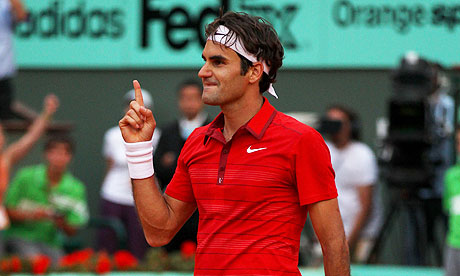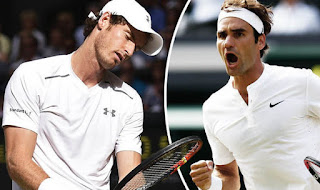
Adieu! Adieu! Thy plaintive single handed backhand fades,
Past the Federers, Stans, Gasquets, over the Karlovics and under the Raitanens,
Up the Henman Hill, (shove off Murray Mound); and now 'tis buried deep behind endemic coaching of prodigious juniors who learneth thine double handed backhand. Oh me! Oh life!
The single handed backhand (shbh). Shakespearian sonnets don't require as much artistry, inherent elegance and awe-inspiring beauty.
If James Earl Jones spoke (https://www.youtube.com/watch?v=4QTwPC3AgU4 - go to 1.06 for the best word ever pronounced!) whilst utilising this majesty - I think the universe would explode.
In years to come this poetic gem of a shot, might just be consigned to the pages of history, adorning the walls of a museum; next to the serve and volley exhibit, slowly accumulating dust.
 |
| Add caption |
"There was once a dream that was
Observe how fragile that shot is today.
Less than 20 players in the men's top 100 use a shbh (down from around 50 a decade ago) and incredibly, 97 female players used a two-hander. That could maybe be forgiven if a host of precocious juniors rekindled this aesthetic flourish.
That isn't the case. The corresponding number in the boys' section shoots up to 95 double handers and 99 out of 100 in the girls' category.
Why is this tragedy being allowed to happen? Long gone are the days when a 14yo Pete Sampras said (paraphrasing): "Be gone, thine left hand and torment me no more, I shall go it alone with righty!" - (basically he went from a double hander to a single to deal with the fast conditions.)
Emmanuel Planque, the coach of Lucas Pouille, ranked 90, offers one explanation into the shot's decline.
"The return," said Planque. "You can't return with a single handed backhand in these (slow, bouncy, spinny, homogenised, power and fitness dominated) conditions."
You can chip a return like Stan Wawrinka does, a blocked return like Tim Henman did, or a reflex flick like only Roger Federer can.
 |
| Serb splits! |
It is a more compact shot. The extra hand provides extra support and strength, a key advantage when dealing with high bouncing balls (a tactic Rafael Nadal has done so well for years on end to Federer), and from a smaller swing it can generally create more power. All this is hugely advantageous to double handers.
Furthermore lighter rackets and polyester strings have all but killed off serve and volley too and bred the current, dominating, baseline tennis.
Don't take my word for it, take science's. In the 70's, Dr Jack Groppel analysed the biomechanics of both shots and concluded the shbh is more difficult to master.
It demanded more synchrony between the hips, legs, trunk, upper arm, forearm and hand - something that wasn't axiomatic in the latter three points for a double hander.
In the lightning fast 90's and decades gone by, the shbh was much more effective and commonly used. It was and still is easier to switch to volleying, execute a slice shot and requires one less step when reaching for a ball. They can be more powerful and can deal with lower balls better.
The tables have certainly turned.
 Carlos Rodriguez, a former coach of Justin Henin - who possessed one of the finest shbh's the game has ever seen - was quoted in a New York Times article, saying that the shot will soon die out in the next five to ten years but not because it isn't effective.
Carlos Rodriguez, a former coach of Justin Henin - who possessed one of the finest shbh's the game has ever seen - was quoted in a New York Times article, saying that the shot will soon die out in the next five to ten years but not because it isn't effective.In his view, its decline is due to impatient coaches and parents who aren't willing to take the extra time to learn the testing one-hander, as it may cause short term losses.
Dusan Lajovic, 25. Grigor Dimitrov, 24. Britain's Dan Evans, 24. Marius Copil, 24. Dominic Thiem, 21. I can't think of many other players who possess a shbh and are born after 1990. Yes there are a few but not nearly enough, just like red squirrels! Darn those greys!
Tennis connoisseurs may not be able to dine on this shot for much longer as even Federer - who last year switched to a larger racquet in search of consistency - believes the future is a two-hander.
If Federer, widely regarded as the game's greatest ever talent, had to switch to a bigger frame, do youngsters have a shot with a shbh?
Djokovic's beloved former coach, Jelena Gencic, encouraged the Serb to adopt the shbh but he felt 'very weak' dealing with high balls to his backhand, and took up the two hander instead. Game, set and match to the double hander.
You get the picture (One picture that lacks a shbh unfortunately).
Possible solution?
Speed up some of the surfaces, vary the size of the tennis balls (i.e. make them smaller and quicker) and dare I say put restrictions on string technology? That last one may be a tad extreme but desperate measures and all that!

 The Northern White Rhino.
The Northern White Rhino.The Amur Leopard.
 The South China Tiger and the shbh.
The South China Tiger and the shbh.All beautiful things that are on the verge of extinction!
This cannot be allowed happen!












